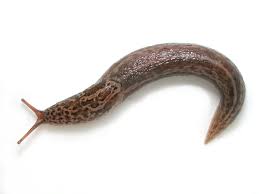Leopard slugs

Limax maximus, more commonly known as leopard slugs or the great grey slug, are one of the largest domestic slugs, right behind the great black slug. The leopard slug is a part of the keeled slug family – the Limacidae family.
Description
Adult slugs measure between 4-8 inches in length. They generally have light gray or gray-brown skin with dark spots or blotches. Each variation of patterns varies per slug. Their body is rounded with a short keel on the tail and two sets of tentacles on their heads. [1] The upper set of tentacles is used to sense light with eye spots on the ends of the tentacles while the lower sets are used to sense smells. The slugs breathe through a hole in the side of their mantle called a pneumostome. Like all other slugs, leopard slugs secrete mucus as they move to protect their foot from damage. This mucus is iridescent and colorless. [1]
Habitat & Feeding Habits
The leopard slug is native to Europe and parts of Northern Africa and has been introduced as an invasive species to North America. Leopard slugs are commonly found in areas with lots of human interaction- gardens, parks, greenhouses, graveyards, and well-wooded areas [2].
Leopard slugs feed on decaying plant material, fungi, lichen and algae. They have also been known to occasionally feed on other slugs and their eggs. [2].
Life Cycle
Leopard slugs lay eggs slightly attached in clusters. These eggs are transparent, elastic, and have a slightly yellowish color. Each egg is approximately 6x4.5 mm and will hatch in about a month. These baby slugs emerge from the eggs after a month and will need two years minimum to reach sexual maturity. Once they reach sexual maturity, they have approximately one year max before the next set of leopard slugs take over. The life span of leopard slugs is 2.5-3 years. [3].
When it is time for leopard slugs to mate these slugs hang off a tree branch by a strong piece of mucus and mate in the air. All leopard slugs are hermaphrodites and will each exchange sperm and then both slugs lay eggs [1].
Ecological Role
Leopard slugs can be beneficial for gardens due to them eating the decaying plant matter. They also prey on other slug species which may damage gardens. Leopard slugs also enrich the soil as decomposers. [4].
References
1. Pedersen, A. (2015, May 3). Leopard Slug. Truckee River Guide. https://truckeeriverguide.org/species/leopard-slug/
2. Leopard Slug. Terrestrial snails and Slugs. (n.d.). https://www.molluscs.at/gastropoda/terrestrial.html?%2Fgastropoda%2Fterrestrial%2Flimax.html
3. Leopard Slug. EOL. (n.d.). https://eol.org/pages/452590/articles#:~:text=Limax%20maximus%20(literally%2C%20%22biggest,species%20of%20the%20genus%20Limax.
4. Taft, D. (2016, July 22). The double life of the slimy, acrobatic leopard slug. The New York Times. https://www.nytimes.com/2016/07/24/nyregion/the-double-life-of-the-slimy-acrobatic-leopard-slug.html#:~:text=Here%20again%2C%20the%20leopard%20slug,%2C%20mussels%2C%20snails%20and%20oysters
5. https://collections.museumsvictoria.com.au/species/8770/media/293313/large